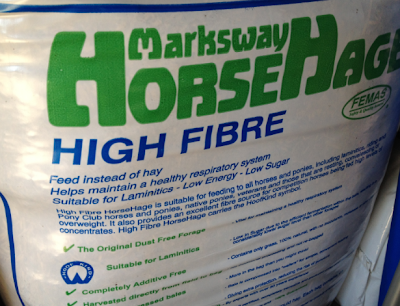FOR WANT OF A SHOE,
THE BATTLE WAS LOST:
Keeping your horses' feet in tip-top condition means a careful combination of management techniques, the right feed with the correct nutrients in it, a great farrier, and a keen eye to notice any changes in the hoof, however subtle.
This time of year, when the ground has gone from totally wet and saturated to rock solid hard and dry back to soggy again in a matter of weeks, it's the time we need to be vigilant with our horses' feet. As the hoof repeatedly becomes saturated then dries out it can crack causing problems due to the expansion and contraction of the hoof wall. All this movement in the horn causes clenches to become loose, and shoes start coming off as a consequence...as Henry's is about to do.
Keep you farrier on speed-dial, and keep your eye out for any signs of change.
There are of course topical treatments you can apply to your horses' hoof wall to moisturise, but Steve contests that an animal with the correct diet and management shouldn't need any of these things....having said that I buy a very costly hoof-supplement and I don't tell him, because I know he wouldn't approve, but it makes me feel better as I have an insurance against nutrition-based hoof problems.

For want of a nail the shoe was lost.
For want of a shoe the horse was lost.
For want of a horse the rider was lost.
For want of a rider the message was lost.
For want of a message the battle was lost.
For want of a battle the kingdom was lost.
And all for the want of a horseshoe nail.
For want of a message the battle was lost.
For want of a battle the kingdom was lost.
And all for the want of a horseshoe nail.
My obsession with my horses’ feet began with my pony Brandy, he was old and developed Cushings disease. In itself not a problem, but it meant my poor Brandy suffered prolonged and almost continuous laminitis.
I learned a lot about feet over that time and developed a greater respect for my farrier, who’s job it was ultimately to help Brandy live a pain-free life.

Tom & Henry have never had laminitis. I am very careful with what I feed them and make sure their fields aren’t too lush, by grazing them appropriately and cutting them when necessary. But, just because they don't suffer with Laminitis, that doesn't mean I don't buy products that are suitable for horses that do.
Look for the Hoof Kind stamp and the Laminitis Trust stamp of approval on feeds. if like me you buy these, you can guarantee you're doing all you can to keep the sugar they consume to the bare minimum.

Horses are designed to roam free over hundreds of acres of scrubby land, with
little nutritious tufts of grass available, but a greater selection of edible
herbs and grasses than they get now. The bulk of their natural diet should be low-calorie forage.
So I keep my land well and truly grazed on, short and never over fertilised –
once every three years only.

Their dinner is simple and forage based BUT I do buy a costly hoof supplement to top up any possible gap in the nutrition where hooves are concerned. It is my thing.
Tom & Henry get shod every 5 weeks, on the front only. I would prefer
to have them barefoot but they have quite shallow feet, meaning their frogs are
shallow, and with all the stones and gravel around our village, they would be
foot-sore all the time and I just couldn’t bear it.
It's difficult to decide what to do with so much contradictory advice, I wouldn't consider any changes to Tom & Henry's management without first discussing it with Steve. Your own farrier knows your horses' feet, he will be able to give you a steer if you have any questions.
Of course, one day Steve will retire, then Tom & Henry might go barefoot...that'll give me a few years to get used to the idea!









No comments:
Post a Comment